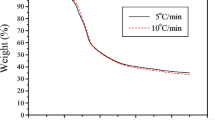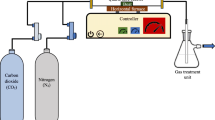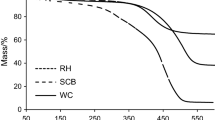Abstract
The aim of this study was to produce renewable energy from exhausted coffee residue, which is a form of biomass. As coffee preference continues to increase, the importation of coffee beans has been increasing sharply. However, the amount of coffee that is actually consumed is only about 0.2% of coffee beans, while the spent coffee beans are discarded in the form of exhausted coffee residue. Hydrothermal carbonization is a method of producing an improved fuel from renewable energy sources by changing the physical and chemical properties of biochars. Biochars were obtained from a variety of reaction temperatures during hydrothermal carbonization and analyzed using elemental analysis, ultimate analysis, and calorific value measurement. The atomic C/O and C/H ratios of all obtained biochars decreased and were found to be similar to those of lignite and sub-bituminous coal. The highest energy recovery efficiency of biochar indicates that the optimum reaction temperature for hydrothermal carbonization was between 210 and 240 °C, which produced biochars with calorific value of approximately 26–27 MJ/kg. The spectra of biochars obtained from Fourier transform infrared spectroscopy (FTIR) showed fewer C–O and aliphatic C–H functional groups, but more carbonyl C=O functional groups and aliphatic CH x groups. The results of this study indicate that hydrothermal carbonization can be used as an effective means to generate highly energy-efficient renewable fuel resources from coffee residue. The thermogravimetric analysis provided the changing combustion characteristics due to increased fixed carbon content.






Similar content being viewed by others

References
Bringezu S, Schutz H, Arnold K, Merten F, Kabasci S, Borelbach P, Michels C, Reinhardt GA, Rettenmaier N (2009) Global implications of biomass and biofuel use in Germany-Recent trends and future scenarios for domestic and foreign agricultural land use and resulting GHG emissions. J Clean Prod 17:S57–S68
Bhat IK, Prakash R (2009) LCA of renewable energy for electricity generation systems—a review. Renew Sust Energ Rev 13(5):1067–1073
Gielen DJ, De Feber MAPC, Bos AJM, Gerlagh T (2001) Biomass for energy or materials? A Western European systems engineering perspective. Energy policy 29(4):291–302
Bridgwater AV (2003) Renewable fuels and chemicals by thermal processing of biomass. Chem Eng J 91(2):87–102
Sims RE, Hastings A, Schlamadinger B, Taylor G, Smith P (2006) Energy crops: current status and future prospects. Glob Change Biol 12(11):2054–2076
Zhou X, Xiao B, Ochieng RM, Yang J (2009) Utilization of carbon-negative biofuels from low-input high-diversity grassland biomass for energy in China. Renew Sust Energ Rev 13(2):479–485
The U.S. Agricultural Trade Office, U.S. Embassy Seoul, Korea, Coffee market brief update Korea-Republic of (Report Number: KS1540). http://gain.fas.usda.gov/Recent%20GAIN%20Publications/Coffee%20Market%20Brief%20Update_Seoul%20ATO_Korea%20-%20Republic%20of_12-31-2015.pdf. Accessed from 31 December 2015
Choi Y, Chang Y, Ryu S, Cho J, Rampal S, Zhang Y, Ahn Y, Lima JAC, Shin H, Guallar E (2015) Coffee consumption and coronary artery calcium in young and middle-aged asymptomatic adults. Heart 101(9):686–691
Tsai WT, Liu SC (2013) Effect of temperature on thermochemical property and true density of torrefied coffee residue. J Anal Appl Pyrolysis 102:47–52
Limousy L, Jeguirim M, Dutournié P, Kraiem N, Lajili M, Said R (2013) Gaseous products and particulate matter emissions of biomass residential boiler fired with spent coffee grounds pellets. Fuel 107:323–329
Tsai WT, Liu SC, Hsieh CH (2012) Preparation and fuel properties of biochars from the pyrolysis of exhausted coffee residue. J Anal Appl Pyrolysis 93:63–67
Kloss S, Zehetner F, Dellantonio A, Hamid R, Ottner F, Liedtke V, Schwanninger M, Gerzabek MH, Soja G (2012) Characterization of slow pyrolysis biochars: effects of feedstocks and pyrolysis temperature on biochar properties. J Environ Qual 41(4):990–1000
Kim D, Lee K, Park KY (2014) Hydrothermal carbonization of anaerobically digested sludge for solid fuel production and energy recovery. Fuel 130:120–125
Kim D, Yoshikawa K, Park KY (2015) Characteristics of biochar obtained by hydrothermal carbonization of cellulose for renewable energy. Energies 8(12):14040–14048
Mumme J, Eckervogt L, Pielert J, Diakité M, Rupp F, Kern J (2011) Hydrothermal carbonization of anaerobically digested maize silage. Bioresour Technol 102(19):9255–9260
Parshetti GK, Hoekman SK, Balasubramanian R (2013) Chemical, structural and combustion characteristics of carbonaceous products obtained by hydrothermal carbonization of palm empty fruit bunches. Bioresour Technol 135:683–689
Berge ND, Ro KS, Mao J, Flora JR, Chappell MA, Bae S (2011) Hydrothermal carbonization of municipal waste streams. Environ Sci Technol 45(13):5696–5703
Zhang JH, Lin QM, Zhao X (2014) The hydrochar characters of municipal sewage sludge under different hydrothermal temperatures and durations. J Integr Agric 13(3):471–482
Parshetti GK, Liu Z, Jain A, Srinivasan MP, Balasubramanian R (2013) Hydrothermal carbonization of sewage sludge for energy production with coal. Fuel 111:201–210
Mursito AT, Hirajima T, Sasaki K (2010) Upgrading and dewatering of raw tropical peat by hydrothermal treatment. Fuel 89(3):635–641
Funke A, Ziegler F (2010) Hydrothermal carbonization of biomass: a summary and discussion of chemical mechanisms for process engineering. Biofuels Bioprod 4(2):160–177
Akkaya AV (2013) Predicting coal heating values using proximate analysis via a neural network approach. Energy Sour Part A 35:253–260
Chen WH, Lu KM, Tsai CM (2012) An experimental analysis on property and structure variations of agricultural wastes undergoing torrefaction. Appl Energy 100:318–325
Fu P, Hu S, Xiang J, Sun L, Su S, An S (2012) Study on the gas evolution and char structural change during pyrolysis of cotton stalk. J Anal Appl Pyrolysis 97:130–136
Hoekman SK, Broch A, Robbins C (2011) Hydrothermal carbonization (HTC) of lignocellulosic biomass. Energy Fuels 25(4):1802–1810
Jones JM, Kubacki M, Kubica K, Ross AB, Williams A (2005) Devolatilisation characteristics of coal and biomass blends. J Anal Appl Pyrol 74(1):502–511
Skousen J, Ziemkiewicz P, Yang JE (2012) Use of coal combustion by-products in mine reclamation: review of case studies in the USA. Geosystem Engineering 15(1):71–83
Yadav V, Baruah BP, Khare P (2013) Comparative study of thermal properties of bio-coal from aromatic spent with low rank sub-bituminous coals. Bioresour Technol 137:376–385
Cao J, Xiao G, Xu X, Shen D, Jin B (2013) Study on carbonization of lignin by TG-FTIR and high-temperature carbonization reactor. Fuel Process Technol 106:41–47
Román S, Nabais JMV, Laginhas C, Ledesma B, González JF (2012) Hydrothermal carbonization as an effective way of densifying the energy content of biomass. Fuel Process Technol 103:78–83
Ibarra J, Munoz E, Moliner R (1996) FTIR study of the evolution of coal structure during the coalification process. Org Geochem 24(6):725–735
Várhegyi G, Szabó P, Till F, Zelei B, Antal MJ, Dai X (1998) TG, TG-MS, and FTIR characterization of high-yield biomass charcoals. Energy Fuels 12(5):969–974
Li XG, Ma BG, Xu L, Hu ZW, Wang XG (2006) Thermogravimetric analysis of the co-combustion of the blends with high ash coal and waste tyres. Thermochim Acta 441(1):79–83
Haykırı-Açma H (2003) Combustion characteristics of different biomass materials. Energy Convers Manag 44(1):155–162
Chen Y, Mori S, Pan WP (1995) Estimating the combustibility of various coals by TG-DTA. Energy Fuels 9(1):71–74
Acknowledgements
This work is financially supported by the Korean Ministry of Environment (MOE) as Waste to Energy and Recycling Human Resource Development Project.
Author information
Authors and Affiliations
Corresponding author
Rights and permissions
About this article
Cite this article
Kim, D., Lee, K., Bae, D. et al. Characterizations of biochar from hydrothermal carbonization of exhausted coffee residue. J Mater Cycles Waste Manag 19, 1036–1043 (2017). https://doi.org/10.1007/s10163-016-0572-2
Received:
Accepted:
Published:
Issue Date:
DOI: https://doi.org/10.1007/s10163-016-0572-2



